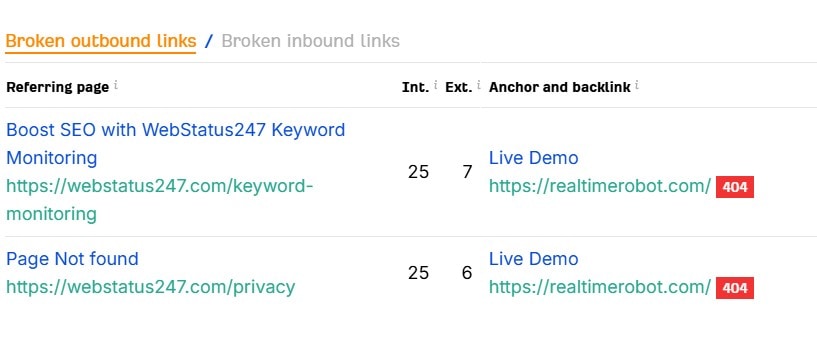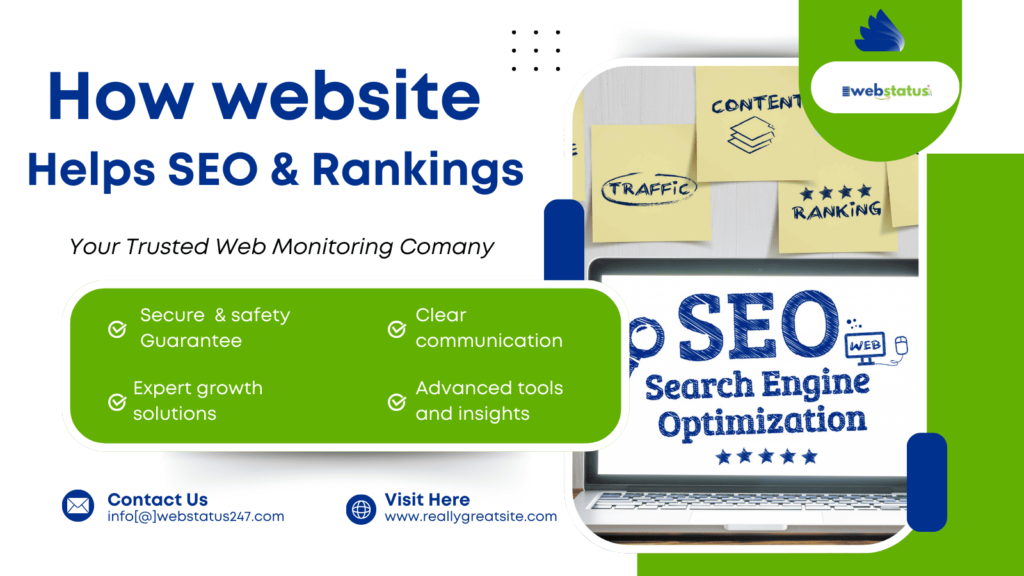In today’s fast-paced digital world, a cutting-edge website is essential for online success. Google rewards user-friendly, fast, and secure sites with higher search engine rankings. Website monitoring—regularly checking uptime, speed, security, and more—ensures your site meets these standards. This article explains how website monitoring supercharges your SEO strategy, driving better visibility and rankings.
1. Maximizing Uptime for SEO Success
Website uptime is the backbone of SEO. Search engines like Google crawl sites regularly to index content. If your site is down, bots can’t access it, and frequent outages can tank your rankings. A 2022 Pingdom study found that sites with over 1% downtime saw a 10-15% drop in organic traffic. Plus, visitors who hit a “503 Service Unavailable” error may never return, eroding trust in your brand.
Tools like WebStatus247 provide real-time alerts for downtime, letting you fix issues fast—often before users or search engines notice.
Key Benefits:
- Keeps your site crawlable for search engine bots.
- Prevents ranking dips from outages.
- Builds user trust with consistent availability.
2. Speeding Up Pages to Meet Google’s Standards

Page speed directly impacts SEO and user experience. Google’s Core Web Vitals—metrics like Largest Contentful Paint (LCP) and First Input Delay (FID)—prioritize sites that load in under 2.5 seconds. Slow pages frustrate users, spiking bounce rates and signaling poor quality to search engines. A 2023 Backlinko study showed that pages loading in 1 second had 3x higher conversion rates than those at 5 seconds.
Website monitoring tools, such as WebStatus247, pinpoint slow-loading culprits—think oversized images or sluggish servers—so you can optimize them quickly.
Key Benefits:
- Meets Google’s speed benchmarks for higher rankings.
- Lowers bounce rates by keeping visitors engaged.
- Boosts conversions with a seamless experience.
3. Fixing Broken Links for a Smooth Journey

Broken links hurt both users and SEO. A “404 Not Found” error disrupts navigation, annoys visitors, and signals neglect to Google. According to Moz, sites with excessive broken links risk losing link equity and facing ranking penalties. For example, a retail site that fixed 50+ broken links saw a 12% traffic boost in two months.
WebStatus247 scans your site for dead links and generates actionable reports, helping you maintain a flawless user experience and strong SEO.
Key Benefits:
- Enhances navigation, keeping visitors on-site longer.
- Preserves link equity for better internal SEO.
- Avoids penalties from search engines.
Curious about link audits? Follow us on Facebook for more tips!
4. Securing Your Site to Avoid Blacklisting
Website security is non-negotiable for SEO. Google prioritizes HTTPS sites and can blacklist those vulnerable to malware or phishing—crashing your traffic overnight. A 2021 Sucuri report noted that 47% of hacked sites saw ranking drops due to security flags. Expired SSL certificates or weak defenses invite trouble.
With WebStatus247, you get security monitoring—think SSL expiration alerts and vulnerability scans—to keep your site safe and search-engine-friendly.
Key Benefits:
- Shields against cyber threats that tank rankings.
- Prevents blacklisting by maintaining HTTPS compliance.
- Builds credibility with a secure user experience.
Learn more: Understanding SSL Certificate Monitoring
5. Perfecting Mobile-Friendliness for Top Rankings
Mobile-first indexing means Google ranks your site based on its mobile version. Unresponsive designs or slow mobile load times can plummet your position. A 2023 Google study found that 53% of mobile users abandon sites taking over 3 seconds to load. Issues like intrusive pop-ups or cramped layouts hurt you further.
WebStatus247 flags mobile compatibility problems—like slow speeds or poor layouts—so you can optimize for Google’s mobile-first world.
Key Benefits:
- Climbs mobile search rankings with a responsive design.
- Cuts bounce rates on mobile devices.
- Aligns with Google’s indexing priorities.
6. Tracking SEO with Real-Time Insights
SEO thrives on data. Website monitoring tools deliver metrics like visitor behavior, bounce rates, and crawl activity. For instance, WebStatus247 tracks search engine bot visits, ensuring your pages get indexed properly. Spotting a sudden bounce rate spike? It might signal a technical glitch—like a slow page—needing a fix.
Businesses using real-time analytics can tweak content and boost visibility faster. A tech blog, for example, cut load times by 2 seconds and saw a 20% ranking jump in three months.
Key Benefits:
- Drives smarter SEO decisions with actionable data.
- Catches technical issues before they harm rankings.
- Reveals user trends for better engagement.
Conclusion: Stay Ahead with Website Monitoring
Website monitoring isn’t optional—it’s your SEO lifeline. Consistent uptime, blazing-fast pages, robust security, and mobile optimization draw more visitors and elevate your Google rankings. Tools like WebStatus247 make it easy, delivering real-time alerts for downtime, speed drops, or security risks. Fix issues before they hit your SEO, and you’ll enjoy higher positions and happier users.
Don’t let a sluggish or shaky site hold you back. Start with WebStatus247 today—try it free and watch your rankings soar. What’s your biggest website challenge? Share below!

Pingback: Best Way to Enhance Domain monitoring for your website